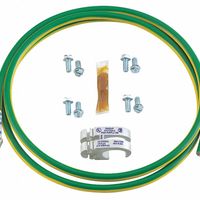Call +(254) 703 030 000 / 751 483 999 / 721 704 777
- Home
- Electrical
- Grounding Rods Braids Connectors
.....Read More
Frequently Asked Questions
What is the purpose of grounding and bonding products?
Grounding and bonding products are essential for electrical safety and system performance. Grounding connects electrical systems to the earth, providing a safe path for fault currents to dissipate, which prevents electric shock and protects equipment from damage during surges or lightning strikes. Bonding, on the other hand, creates a continuous conductive path between metallic objects that are not designed to carry current, ensuring that they remain at the same electrical potential. This prevents the buildup of dangerous voltage differences between components, further reducing the risk of electric shock and minimizing electromagnetic interference. Together, grounding and bonding create a robust electrical system that is safe, reliable, and efficient.
How do grounding braids work in electrical panels?
Grounding braids, often made of braided copper wire, are crucial components in electrical panels, ensuring safety and proper system function. They work by providing a low-impedance path for fault currents to safely return to the ground. In the event of an electrical fault, such as a short circuit, excess current can flow through metal components, posing a shock hazard or damaging equipment. Grounding braids create a direct and reliable connection between these metal parts (like the panel enclosure, subpanels, or large electrical components) and the main grounding electrode system.
Their braided construction offers flexibility, allowing them to absorb vibrations and thermal expansion/contraction without breaking the connection, which is important in dynamic electrical environments. This flexibility also makes them easy to install in various configurations. The high surface area of the braided wires helps to efficiently dissipate heat generated by fault currents. By providing a stable and continuous ground path, grounding braids protect personnel from electrical shock, prevent damage to sensitive electronics, and help circuit breakers and other protective devices trip effectively during a fault, isolating the problem and maintaining overall system integrity.
What are grounding rods used for in outdoor applications?
Grounding rods are essential components in outdoor electrical systems, primarily used to provide a safe path for fault currents to dissipate into the earth. Their main purpose is to protect people from electrical shock and to prevent damage to electrical equipment by stabilizing voltage during power surges or lightning strikes. In outdoor applications, where exposure to weather elements and the risk of lightning are higher, grounding rods are driven deep into the ground to achieve a low-resistance connection with the earth. This connection helps to divert excess electrical energy away from sensitive equipment and into the ground, thereby minimizing the potential for fires, explosions, or system failures. They also play a crucial role in ensuring the proper operation of ground fault circuit interrupters (GFCIs) and other safety devices, which rely on a solid ground connection to detect and interrupt hazardous electrical conditions. In essence, grounding rods act as a critical safety net, safeguarding both property and lives in outdoor electrical installations.
How do grounding clamps connect conductors to pipes and rods?
Grounding clamps are essential components in electrical systems, designed to create a secure and low-resistance connection between electrical conductors and grounding electrodes, such as pipes or rods. This connection is crucial for safety, as it provides a path for fault currents to safely dissipate into the earth, preventing electrical shocks and damage to equipment.
The connection process typically involves a robust mechanical design. Grounding clamps are often made from corrosion-resistant materials like bronze or copper, ensuring durability and excellent conductivity. They feature a clamping mechanism, such as screws, bolts, or a U-bolt design, that allows them to firmly grip the grounding electrode. The conductor, which could be a wire or cable, is then inserted into a designated lug or terminal on the clamp and secured, usually with a set screw or crimping. When tightened, the clamp creates a strong physical and electrical bond, ensuring continuous contact and a reliable grounding path.
What is the difference between grounding and bonding?
Grounding and bonding are essential electrical safety practices that prevent electrical shock and equipment damage. Grounding connects an electrical system or equipment to the earth, providing a safe path for fault currents to dissipate. This connection helps to stabilize voltage and protect against lightning strikes and power surges. Bonding, on the other hand, involves connecting all metallic components in an electrical system that are not designed to carry current, such as metal enclosures, conduit, and piping. This creates an electrically continuous path, ensuring that all bonded components are at the same electrical potential. In the event of a fault, bonding prevents a difference in potential between these metallic parts, reducing the risk of electric shock. While distinct, grounding and bonding work together: bonding ensures all exposed conductive surfaces are at the same potential, and grounding provides a path to earth for fault currents from these surfaces.
Why is it important to prevent static electricity buildup?
Preventing static electricity buildup is crucial in many environments due to the potential for significant hazards and damage. When static charges accumulate on surfaces or objects, they can suddenly discharge, leading to sparks. In industrial settings, especially those dealing with flammable gases, liquids, or dust, these sparks can ignite explosions or fires, posing severe risks to personnel and property.
Beyond fire and explosion risks, static electricity can cause damage to sensitive electronic components. Integrated circuits and other microelectronic devices are highly susceptible to electrostatic discharge (ESD), which can lead to immediate failure or latent damage that shortens their lifespan. This is a major concern in manufacturing, assembly, and handling of electronics.
Static buildup can also disrupt manufacturing processes, particularly in industries involving textiles, paper, or plastics. Static charges can cause materials to stick together, repel each other, or attract dust and contaminants, leading to production inefficiencies, quality issues, and increased waste. For personal comfort and safety, static shocks can be startling and painful, though usually harmless. Therefore, measures like grounding, humidification, and antistatic materials are implemented to control static electricity and mitigate these risks.
How do isolated ground bars function in tight spaces?
Isolated ground bars function in tight spaces by providing a dedicated grounding path for sensitive electronic equipment, separate from the main electrical grounding system. This isolation helps prevent electrical noise and interference from affecting the equipment's performance, which is especially crucial in environments where space constraints might lead to crowded wiring or proximity to other electrical components.
In tight spaces, traditional grounding methods can be challenging to implement effectively due to limited room for proper wire routing and connection points. Isolated ground bars overcome this by offering a compact and centralized solution. They are typically mounted within an enclosure or on a panel, and individual equipment ground wires are connected directly to the isolated ground bar. This creates a star ground configuration, where each piece of equipment has its own direct, low-impedance path to the isolated ground, minimizing ground loops and common-mode noise.
Their compact design and clear labeling make them easy to install and maintain in confined areas, reducing the risk of wiring errors and improving troubleshooting efficiency. By dedicating a separate grounding system, isolated ground bars ensure the reliability and stability of sensitive electronics, even in challenging space-constrained applications.
What are grounding strips and busbars used for?
Grounding strips and busbars are essential components in electrical systems, primarily used for grounding and power distribution, respectively.
Grounding strips, also known as ground straps or bonding strips, are flexible conductive strips, often made of braided copper. Their main purpose is to provide a low-resistance path for fault currents to safely dissipate into the earth. This is crucial for electrical safety, as it helps prevent electrical shocks, protects equipment from damage due to overvoltage, and minimizes electromagnetic interference. They are commonly used to bond metal enclosures, racks, and equipment frames to the main grounding system, ensuring all metallic parts are at the same electrical potential. This prevents potential differences that could lead to dangerous touch voltages during a fault.
Busbars, on the other hand, are rigid conductors, typically made of copper or aluminum, that serve as a common junction for distributing electrical power. They are designed to carry large currents and are used in various applications, including electrical panels, switchgear, and data centers. Busbars provide a neat and organized way to connect multiple circuits, offering a more efficient and reliable alternative to numerous individual wires. They are often found in configurations that allow for easy expansion and modification of electrical systems. Busbars can be solid, hollow, or laminated, depending on the current carrying capacity and space requirements.
How do grounding crimping connectors work?
Grounding crimping connectors provide a secure and reliable electrical connection, primarily used to ensure proper grounding in various applications. They work by mechanically deforming a metal sleeve or barrel around a conductor (wire) and a grounding point, typically a lug or a terminal. This deformation creates a cold weld between the connector and the wire, establishing a low-resistance electrical path. The process involves inserting a stripped wire into the connector's barrel and then using a specialized crimping tool to apply pressure. The tool's dies are designed to compress the connector material evenly around the wire, ensuring maximum contact area and preventing air voids that could lead to corrosion or increased resistance. The quality of the crimp is crucial for long-term reliability and safety, as a poor connection can lead to overheating, electrical noise, or even arc faults. These connectors are commonly used in electrical panels, automotive systems, and telecommunications equipment to protect against electrical surges and ensure the safe dissipation of fault currents.
What are the safety benefits of grounding and bonding in electrical systems?
Grounding and bonding are critical safety measures in electrical systems. Grounding provides a safe path for fault currents to return to the source, preventing dangerous voltage buildup on equipment enclosures and reducing the risk of electric shock. In the event of an insulation breakdown, the fault current flows through the ground path, tripping protective devices like circuit breakers or fuses, and de-energizing the faulty circuit. This prevents electrocution and minimizes damage to electrical equipment.
Bonding, on the other hand, creates a continuous, low-impedance path between all metallic components in an electrical system that are not intended to carry current during normal operation. This ensures that all exposed conductive surfaces are at the same electrical potential, eliminating potential differences that could cause current to flow through a person coming into contact with two different metallic objects. This is crucial for preventing arc flashes, electric shocks, and fires. Together, grounding and bonding form a comprehensive safety system that protects personnel, equipment, and structures from the hazards of electrical faults.





